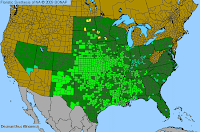Bundleflower is Desmanthus illinoensis, Wood Rose, Prickleweed, False Sensitive Plant, etc.
Wildflowers are important to add a light touch to a
cottage garden or for building a wildscape area that can help birds thrive.
Native trees, flowers and grasses are more adaptive; harsh winter or summer
weather cannot keep them down. They provide nectar for insects, attracting
pollinators to our vegetable gardens and home grown fruit.
Most wildflowers take lots of sun but are not very particular
about soil quality. Planting native grasses in your garden or shrub row will
attract songbirds as well as quail, doves, cardinals, sparrows, and other
seed-eaters.
Native grasses to consider include: Bluegrass, Bluestem,
Bristlegrass, Buffalograss, Bundleflower, Dropseed, Gamagrass, Grama, Lovegrass,
and Wintergrass.
 |
| Desmanthus native range - PollenLibrary.com |
Illinois Bundleflower or Desmanthus illinoensis is native in USDA zones 5 through 8, most of the
central and southern U.S. mainland states. Its range skips the east and west
coasts as well as Montana and Nevada.
 |
| Erowid.com |
The butterfly attracting, one-half-inch
wide spring flowers resemble those found on Buttonbush. The flowers bloom from
May to September. They are white but have yellow stamens that extend beyond the
flower making it resemble a bottlebrush flower. The leaves resemble those of a Mimosa
tree but the seed pod is completely unique to Bundleflowers.
The unique seed pod is where
Bundleflowers acquired another name: Wood Rose. The dark brown curved pods
twist into a cluster, remaining on the plant well into the winter when wildlife
find them. The seeds are a favorite of Northern Bobwhite Quail.
A member of the legume or pea
family, Bundleflower seeds are highly valued by birds and wildlife as a winter
protein source. Easy to grow from seed, Bundleflowers can take soil that is dry
to wet but not coarse sand or dense clay. At the Missouri Botanical Garden, it
is grown in the Rock Garden and in our yard it grows well with afternoon
protection under the shade of larger plants.
Bundleflower is popular with
honey bees so if the young plants are left alone by foraging rabbits, it can
become plentiful in prairies and along country roads through re-seeding. Since
it is a legume, it is helpful in building soil fertility and improving soil
quality.
 |
| Desmanthus seedpod in August |
This is a plant that requires persistence in research because it is
referred to by so many different names in books and catalogs, including Prairie
mimosa, Prairie Bundleflower, False Sensitive Plant, Sabine Illinois
bundleflower, Prickle-weed, Wood Rose, Mimosa illinoensis, Reno Germplasm
Illinois bundleflower and its Latin name Desmanthus.
The False Sensitive Plant name
comes from the leaves’ sensitivity. The leaves close inward at night, when they
are struck by direct sunlight and when they are touched.
In a single growing season,
Bundleflower plants’ soft stems can grow to 4-feet tall and flop over. Some
gardeners consider them weedy or informal in appearance and tuck them out of
sight.
Because of their soil building
qualities, Bundleflowers are planted to restore mined land. Native Americans
used them for many medicinal purposes. For example, the Pawnees used a tea made
from the leaves to relieve itching and the Hopi placed seeds on the eyes for
conjunctivitis (pink eye or trachoma).
Bundleweed has no insect or
disease problems. The seeds are available from catalogs that are interesting to
browse: Native American Seed at www.seedsource.com in the wildflower section, from Native Seed
Network at www.nativeseednetwork.org and Roundstone Native Seed at www.roundstoneseed.com.
 |
| http://www.wildflower.org/ |
Seed germination can take
2-weeks in 65-degree weather but that time can be shortened by soaking the
seeds in hot water overnight. A legume inoculum that is commonly added when
planting garden peas can also be used. Plant seeds ¼ to ½ inch deep directly in
the garden and keep the soil moist.
For more information: The
Great Plains Nature Center at www.gpnc.org.



Comments